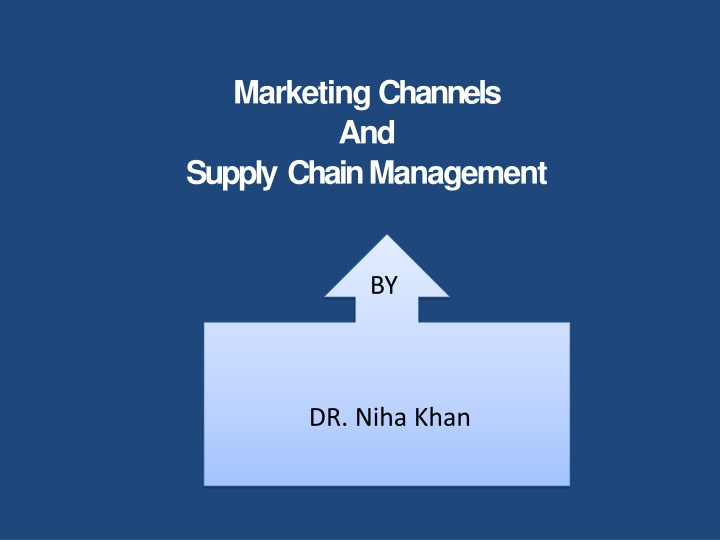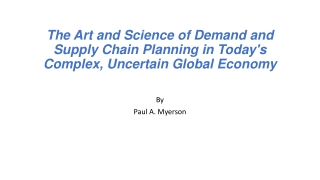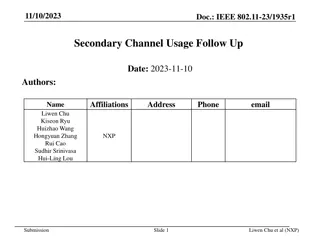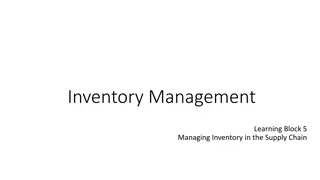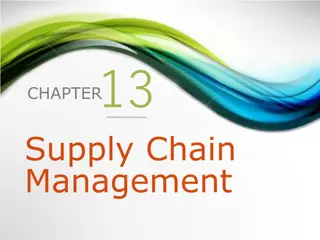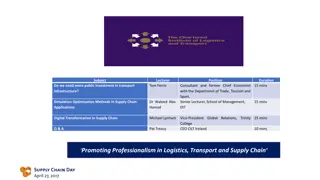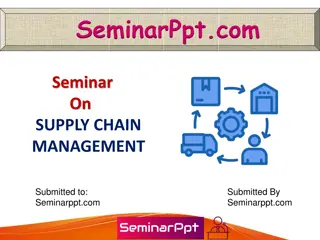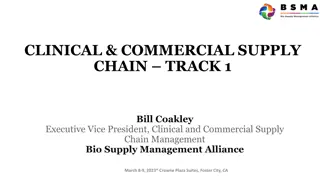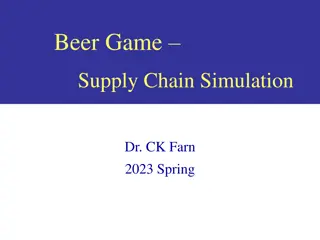Marketing Channels and Supply Chain Management
In this comprehensive guide by Dr. Niha Khan, learn about how companies use marketing channels, the interactions and organization of channel members, major channel alternatives, selection and evaluation of channel members, and the significance of marketing logistics in integrated supply chain management. Explore supply chains, value delivery networks, channel behavior, design decisions, management decisions, public policy, and more.
Download Presentation

Please find below an Image/Link to download the presentation.
The content on the website is provided AS IS for your information and personal use only. It may not be sold, licensed, or shared on other websites without obtaining consent from the author.If you encounter any issues during the download, it is possible that the publisher has removed the file from their server.
You are allowed to download the files provided on this website for personal or commercial use, subject to the condition that they are used lawfully. All files are the property of their respective owners.
The content on the website is provided AS IS for your information and personal use only. It may not be sold, licensed, or shared on other websites without obtaining consent from the author.
E N D
Presentation Transcript
Marketing Channels And Supply Chain Management BY DR. Niha Khan
LearningObjectives After studying this chapter, youshould be able to: 1. Explain how companies use marketing channels anddiscuss the functions these channelsperform 2. Discuss how channel members interact and howthey organizeto perform the work of the channel 3. Identify the major channelalternativesopento acompany 4. Explain how companies select, motivate, andevaluate channelmembers 5. Discuss the nature and importance of marketinglogistics and integrated supply chainmanagement 12-2
ChapterOutline 1. 2. 3. 4. 5. 6. 7. Supply Chains and the Value Delivery Network The Nature and Importance of MarketingChannels Channel Behavior andOrganization Channel DesignDecisions Channel ManagementDecisions Public Policy and Distribution Decisions Marketing Logistics and Supply Chain Management 12-3
Supply Chainsand theValue DeliveryNetwork Supply Chain Partners Upstreampartnersinclude raw material suppliers, components, parts, information, finances, and expertise to createaproduct orservice Downstream partners include the marketingchannels or distribution channels that look toward the customer 12-4
Supply Chainsand theValue DeliveryNetwork Supply Chain Views Supply chain make and sell view includes the firm sraw materials, productive inputs, and factorycapacity Demand chain sense and respond view suggests thatplanning starts with the needs of the target customer and the firm responds to these needs by organizing a chain of resources andactivities with the goalof creating customervalue 12-5
Supply Chainsand Value Delivery Network the Value Delivery Network The value delivery network is the firm s suppliers, distributors, and ultimately customers who partner with each other to improve the performance of the entiresystem 12-6
Supply Chainsand Value DeliveryNetwork the Marketing Channel Questions What is the nature ofmarketing channels and why are theyimportant? How do channel firms interact and organize todo the work of thechannel? What role do physical distribution and supplychain management play in attractingcustomers? 12-7
TheNatureandImportanceof Marketin g Channels Marketing Channel Defined Marketing channel is a set of independent organizations that help make a product or service available for use or consumption by theconsumer or businessusers 12-8
TheNatureandImportanceof Marketin g Channels How Channel Members Add Value Channel members add value by bridging the major time, place, and possession gaps that separate goods and services from those who would usethem 12-9
The Nature and Importanceof Marketing Channels How Channel Members Add Value Producers use intermediaries because they create greater efficiency in makinggoods available to targetmarkets. 12-10
The Nature and Importanceof Marketing Channels How Channel Members Add Value Intermediariesoffer the firm more thanit canachieve on its own through their contacts, experience, specialization, and scale of operations 12-11
The Nature and Importanceof Marketing Channels How Channel Members Add Value From an economic view, intermediaries transform the assortment of productsinto assortments wanted byconsumers 12-12
The Nature and Importance of Marketing Channels How Channel Members Add Value Information refers to the gathering and distributingresearch and intelligence information about actors and forces in the marketing environment needed for planning and aidingexchange Promotion refers to the development andspreading persuasive communications about anoffer Contacts refers to finding and communicatingwith prospectivebuyers 12-13
TheNatureandImportanceof Marketin g Channels How Channel Members Add Value Matching refers to shaping and fitting the offer to the buyer s needs, including activities such as manufacturing, grading, assembling, andpackaging Negotiationrefers to reachinganagreementonprice and other terms of the offer sothat ownership or possessioncanbetransferred 12-14
TheNatureandImportanceof Marketin g Channels How Channel Members Add Value Physical distribution refers to transporting and storinggoods Financing refers to acquiring and using funds tocover the costs or carrying out the channelwork Risk taking refers to assuming the risks of carrying outthe channelwork 12-15
TheNatureandImportanceof Marketin g Channels Number of Channel Members Channel level refers to each layer of marketingintermediaries that performs some work in bringing the product and its ownership closer to the finalbuyer Direct marketing channel has no intermediary levels; the company sells directly toconsumers Indirect marketing channels contain one or moreintermediaries 12-16
The Nature and Importanceof Marketing Channels Number of Channel Members Connected by types offlows: Physical flow ofproducts Flow of ownership Payment flow Information flow Promotion flow 12-17
Channel Behavior andOrganization Channel Behavior Marketing channel consists of firms that have partnered for their commongoodwith each member playing a specializedrole 12-18
Channel Behavior andOrganization Channel Behavior Channel conflict refers to disagreement overgoals, roles, and rewards by channelmembers Horizontalconflict Verticalconflict 12-19
Channel Behavior andOrganization Channel Behavior Horizontal conflict is conflict among members at the same channellevel Vertical conflict is conflict between different levelsof the samechannel 12-20
Channel Behavior andOrganization Conventional Distribution Systems Conventional distribution systems consist of one or more independent producers, wholesalers, and retailers. Each seeks to maximize its own profits andthere is little control overthe other members and no formal means for assigning roles and resolvingconflict. 12-21
Channel Behavior andOrganization Vertical Marketing Systems Vertical marketing systems (VMS) provide channel leadership and consist of producers, wholesalers, and retailers acting as a unified system and consist of: Corporate marketing systems Contractual marketing systems Administered marketingsystems 12-22
Channel Behavior andOrganization Vertical Marketing Systems Corporate vertical marketing system integrates successive stages of production and distribution under singleownership 12-23
Channel Behavior andOrganization Vertical Marketing Systems Contractual vertical marketing system consists of independent firms at different levels of production and distribution who join together through contracts to obtain more economies orsales impact than each could achieve alone. The most common form is the franchiseorganization. 12-24
Channel Behavior andOrganization Vertical Marketing Systems Franchise organization links several stages in the production distributionprocess Service firm-sponsored retailer franchisesystem Manufacturer-sponsored retailer franchise system Manufacturer-sponsored wholesaler franchisesystem 12-25
Channel Behavior andOrganization Vertical Marketing Systems Administered vertical marketing system has a few dominant channel members without common ownership. Leadership comes from size and power. 12-26
Channel Behavior andOrganization Horizontal Marketing Systems Horizontal marketing systems include two or more companies at one level that join together to follow a new marketing opportunity.Companies combine financial, production, or marketing resources to accomplish more than any one company couldalone. 12-27
Channel Behavior andOrganization Multichannel Distribution Systems Hybrid Marketing Channels Hybrid marketing channels exist when a single firm sets uptwo or more marketingchannelsto reach one or more customersegments 12-28
Channel Behavior andOrganization Multichannel Distribution Systems Hybrid Marketing Channels Advantages New opportunities to tailorproducts and services to specific needs of diverse customersegments Challenges Create channelconflict Increased sales and marketcoverage Hard to control 12-29
Channel Behavior andOrganization Changing Channel Organization Disintermediation occurs when product or service producers cut out intermediaries and go directly to final buyers,or whenradicallynewtypesof channel intermediaries displace traditionalones 12-30
Channel DesignDecisions Analyzing Consumer Needs Designing a channel systemrequires: Analyzing consumerneeds Setting channelobjectives Identifying major channelalternatives Evaluation 12-31
Channel DesignDecisions Analyzing Consumer Needs Designing a marketing channel starts with findingout what target customerswant from the channel 12-32
Channel DesignDecisions Setting Channel Objectives In termsof: Targeted levels of customerservice What segments to serve Best channels to sue Minimizing the cost of meeting customerservice requirements 12-33
Channel DesignDecisions Setting Channel Objectives Objectives are influencedby: Nature of the company Marketing intermediaries Competitors Environment 12-34
Channel DesignDecisions Identifying Major Alternatives In termsof: Types of intermediaries Number ofintermediaries Responsibilities of each channelmember 12-35
Channel DesignDecisions Identifying MajorAlternatives Types of intermediaries refers to channel members available to carry out channel work. Examples include: Company sales force Manufacturer sagency Industrial distributors 12-36
Channel DesignDecisions Identifying Major Alternatives Company sales force strategies Telesales Expand direct sales force Assign outside salespeople to territories Develop a separate sales force 12-37
Channel DesignDecisions Identifying MajorAlternatives Manufacturer s agencies are independent firms whose sales forces handle related products from many companies in different regions orindustries 12-38
Channel DesignDecisions Identifying Major Alternatives Industrialdistributors Find distributors in different regions orindustries Exclusivedistribution Marginopportunities Training Support 12-39
Channel DesignDecisions Identifying MajorAlternatives Number of marketing intermediaries touse at each level S trategies: Selectivedistribution Intensive distribution Exclusive distribution 12-40
Channel DesignDecisions Identifying MajorAlternatives Intensive distribution is a strategy used by producers of convenience products and common raw materials in which they stock their products in as many outlets aspossible 12-41
Channel DesignDecisions Identifying Major Alternatives Exclusive distribution is a strategy in which the producer gives only a limited number ofdealers the exclusive right to distribute its products in their territories Luxuryautomobiles High-endapparel 12-42
Channel DesignDecisions Identifying MajorAlternatives Selective distribution is a strategy when a producer uses more than one but fewer than all of the intermediaries willing to carry the producer s products T elevisions Appliances 12-43
Channel DesignDecisions Responsibilities of Channel Members Producers and intermediaries need to agreeon: Price policies Conditions ofsale Territorial rights Services provided by eachparty 12-44
Channel DesignDecisions Evaluating the MajorAlternatives Each alternative should be evaluatedagainst: Economiccriteria Control Adaptivecriteria 12-45
Channel DesignDecisions Evaluating the Major Alternatives Economic criteria compares the likely sales costs and profitability of different channelmembers Control refers tochannel members control over the marketing of theproduct Adaptivecriteriarefersto the ability to remainflexible to adapt to environmentalchanges 12-46
Channel DesignDecisions Designing International Distribution Channels Channel systems can vary from country to country Must beableto adaptchannelstrategiesto the existing structures within eachcountry 12-47
Channel ManagementDecisions Channel managementinvolves: Selecting channel members Managing channel members Motivating channelmembers Evaluating channelmembers 12-48
Channel ManagementDecisions Selecting Channel Members Selectingchannel members involves determining the characteristics that distinguishthe better onesby evaluatingchannelmembers Profit record Years in business Lines carried 12-49
Channel ManagementDecisions Selecting Channel Members Selecting intermediaries that are sales agentsinvolves evaluating: Size and quality of salesforce Number and character of other linescarried 12-50
